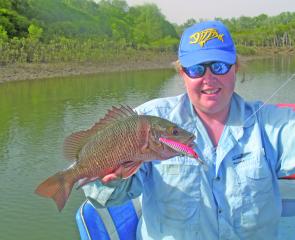What a great barra season we had this year. Whether it's down to the good wet we had last year or the fact that the Gulf netters flooded the market with barra fillets ‑ making catching one a lot more effort than buying one. Regardless why, our barra season was one of the best this year and I can’t wait to fish the run off after the next wet.
However, barra are now off the wish list for a few months from the 1 November through to the 1 February, unless you take advantage of the stocked impoundments scattered throughout the state. A permit to fish in these waterways is required and a bag limit of one fish per person is also in place. Now I can already hear some readers saying why would you want to eat a freshwater barra? Well, if you choose a big black or dark looking barra, chances are he has been living in the weed, but if he is a clean, silver fish he will not have a weedy taste and even the biggest critic will have to eat their words (so to speak).
If you live too far to travel to a dam or lake and still want something to do, you can’t go past a little wet season crabbing or chasing jacks. As the summer storms drop reasonable downloads overnight, the crabs will start to move down closer the creek and river mouths ready to leave for the saltwater of the bays and headlands as floodwaters build. The bigger tides on the full and new moons tend to see the crabs moving out of their holes and foraging.
Prawns also make a move during freshwater flushes and big summer tides. The best way to find a feed of prawns is at low tide and work around gutter mouths and holes in creek mouths, such as the Gordon. You will need to learn how to use a cast net so a visit to the local tackle store is compulsory. To find out the best places to start looking it pays to keep an eye on the locals.
When it comes to November jacks, then it's time to timber bash. Jacks live in structure, from snags and fallen trees to rocks, mooring poles, bridges and wrecks. Whether you're tossing lures or bait, Townsville has easy access to all of these.
Every creek in the region has snags and fallen timber in them. The more productive snags will have plenty of branches in the water at least a metre deeper than the creek average depth, so check out the bends as the tides normally dig out the outside.
The tides should also provide current even on neap tides, albeit very slow current. Bait should be close by, if not on the snag as well. But if you find a deep snag on a bend covering a gutter for the bait to hide, chances are you just found your favourite jack snag this summer!
The most well known creek is the rock bar at the mouth of the Bohle River, just north of town, and our harbour rock walls hold really good numbers of jacks for those willing to put the time into finding them. Ross River and Ross Creek have mooring poles and bridges worth looking around for jacks.
No matter what sort of structure you’re going to fish, by far the easiest way to fool a jack is by fishing at night. Jacks will come further out of their hidey holes to feed and you have a better chance of landing them in the dark.
Baiting for jacks is easy. Use a size down from barra baits, such as a small poddy mullet, green back herring or prawn. Also try using the fillets off mullet and herring, and the humble pilchard unweighted in the structure is deadly on jacks.
For lure fishers, the top jack lures at the moment are either C-lure Jack Snacks or the Tilsan Minnow ‑ Both are a wooden non-rattling lure. The Tilsan is a little slower on the float and a better option when the tides are steady. When using plastics you can speed up or slow down their sink rate depending on how you rig them. There have been plenty of articles in this magazine in the past on how to do this, but if you haven’t been keeping your old copies check out the web or your local tackle store for a demonstration.
November is the start of two things; fingermark season and the stupid coral fin fish closure. I call the fin fish closure stupid because in the last three years the government closure period has not coincided with coral reef fish spawning, ‑ gotta love those scientists!
Anyway, fingermark will spawn over the next eight weeks and only fish over 70cm will be mature enough to add to the future numbers of our stocks. So please, take only what you need and any fish over 80cm release it as quickly as possible. This way you are protecting your fishing for years to come.
Reads: 5777
Natsumi’s 75cm barra, the biggest of 16 caught over the weekend.

This jack ate a trolled lure meant for a barra, but no one was complaining.




